Silverback Gorillas are the largest primates on earth. After bonobos and chimpanzees, gorillas are the closest relatives to humans (Their DNA is about 98% similar to that of humans). Gorilla are found in the great forests of East, Central and Western Africa. Gorillas are dived into two main species – The eastern gorilla and the western gorilla.
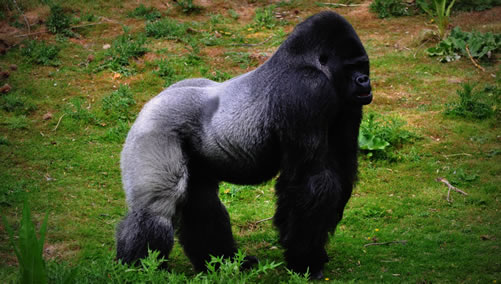 The western gorilla is divided into two subspecies – The western lowland gorilla and the Cross river gorilla. Eastern gorillas include the Mountain gorilla and the Eastern Lowland Gorilla (Also known as Grauers Gorilla). Of all the gorilla subspecies, the Eastern Lowland gorilla is the largest, followed by the mountain gorilla. The Cross River gorilla is the smallest of the lot.
The western gorilla is divided into two subspecies – The western lowland gorilla and the Cross river gorilla. Eastern gorillas include the Mountain gorilla and the Eastern Lowland Gorilla (Also known as Grauers Gorilla). Of all the gorilla subspecies, the Eastern Lowland gorilla is the largest, followed by the mountain gorilla. The Cross River gorilla is the smallest of the lot.
There are currently over 300,000 Western lowland gorillas, 5000 Eastern lowland gorillas, 1,000 mountain gorillas and less than 400 Cross river gorillas. All subspecies of gorillas are considered critically endangered by the International Union for Conservation of Nature (IUCN). This is because their numbers have reduced considerably in the last century. Human diseases, habitat destruction and poaching for meat are the greatest threat to wild gorilla survival.
Silverback Gorilla – Size, height and lifespan
Gorillas live in groups or families led by a Silverback. Silverback doesn’t refer to a particular species of gorillas but a mature male gorilla. Silverback gorillas are distinguished by a grayish white hairline around the back and shoulders. A male gorilla that is too old to be a juvenile but too young to be a 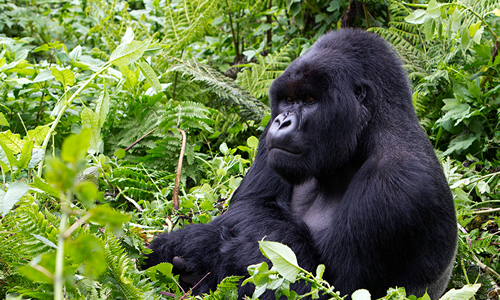 silverback is referred to as a blackback. A silverback is much larger than a female. Compared to a female, a silverback gorilla has a larger head, body and can weigh up to 270 kilograms. A male gorilla becomes an adult at about 8 years of age. This is the time most leave the group to leave alone or join other males. At this point, they are still referred to as Blackbacks. It is only when they become fully grown (at about 12 to 13 years of age) that they become silverbacks. This is also the time when the hair down their back and across the shoulders becomes whitish or greyish in color.
silverback is referred to as a blackback. A silverback is much larger than a female. Compared to a female, a silverback gorilla has a larger head, body and can weigh up to 270 kilograms. A male gorilla becomes an adult at about 8 years of age. This is the time most leave the group to leave alone or join other males. At this point, they are still referred to as Blackbacks. It is only when they become fully grown (at about 12 to 13 years of age) that they become silverbacks. This is also the time when the hair down their back and across the shoulders becomes whitish or greyish in color.
A mature and lone blackback or silverback will live close to a particular group and attempt to dethrone the dominant silverback as soon as he is strong enough. If he fails to dethrone a leader of a particular gorilla family, he will attempt to steal females from that group to form his own.
It is important to note that some males never leave their original group on reaching maturity. They will stay loyal to the dominant silverback and help protect the group from intruders. This arrangement is more common with mountain gorillas and rare with Western lowland gorillas.
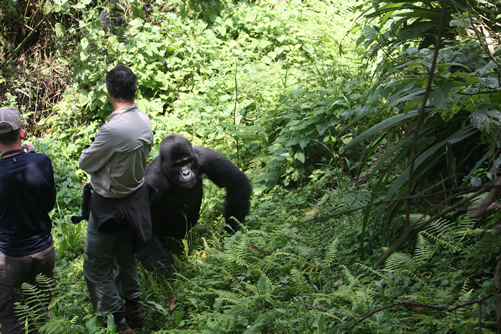 Whereas it is possible to find several silverback gorillas in a group, there is only one dominant silverback. The dominant silverback is the leader of the group and has absolute authority. He dictates what it to be done and when. He determines when to eat, rest and is entitled to mate with all the females in the group. Gorilla mating is often initiated by the female upon reaching maturity. The dominant silverback controls a group containing between 5 to 35 individuals. A gorilla group contains several females, adolescents/juveniles, infants and some adult males. Females leave the group upon reaching maturity to avoid mating with the father.
Whereas it is possible to find several silverback gorillas in a group, there is only one dominant silverback. The dominant silverback is the leader of the group and has absolute authority. He dictates what it to be done and when. He determines when to eat, rest and is entitled to mate with all the females in the group. Gorilla mating is often initiated by the female upon reaching maturity. The dominant silverback controls a group containing between 5 to 35 individuals. A gorilla group contains several females, adolescents/juveniles, infants and some adult males. Females leave the group upon reaching maturity to avoid mating with the father.
Strength of a silverback gorilla?
A fully grown silverback gorilla is about twice the weight of an adult man. They are over 9 times stronger than an adult male. Their body weight and incredible strength is all because of a higher ratio of muscle mass. Would a strong adult male have a chance against a silverback in a duel? Whereas no fight has been recorded between an adult male and a silverback gorilla, it is obvious who the winner will be. An angry silverback would beat the man to a pulp. That side silverback gorillas are not aggressive unless threatened.
Are silverback gorillas aggressive?
The dominant silverback gorilla leads by charisma and example. He is always peaceful and rarely uses force. A silverback gorilla only becomes aggressive when it encounters a threat, intruders or if he wants to assert dominance. Intruders can mean males from other groups, stubborn members of his group,  animals like leopards or humans visiting a group that is not habituated. When a silverback gorilla recognizes a threat or silverback from another group, he will first attempt to warn off the intruder. He does this by standing up while drumming up his chest.
animals like leopards or humans visiting a group that is not habituated. When a silverback gorilla recognizes a threat or silverback from another group, he will first attempt to warn off the intruder. He does this by standing up while drumming up his chest.
If the above action doesn’t work, he will tear up and through plants at the intruder while making a deafening sound. The silverback will then make a mock attack using all four legs. If all this doesn’t work and the threat or intruder hasn’t yet got the message, the silverback will attack directly and deliver a blow with the hands or teeth. A silverback gorilla will defend his group and especially infants to the death. It is one reason why poachers and pet traders target the silverback if they wish to capture an infant.
What do silverback gorillas eat?
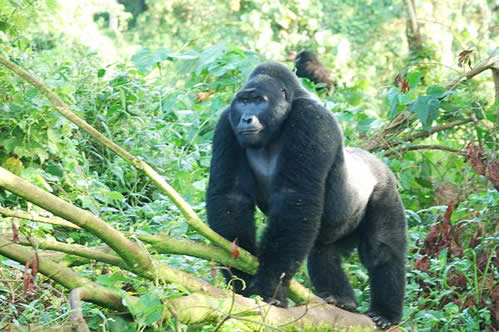 Silverback gorillas in general eat mainly plants. This can consist of fruits, shoots and leaves. They also love termites, ants and certain insects. Mountain gorilla silverback diet is slightly different. It consists of mainly stems and leaves. They may also feed on fungi, flowers and bark. The season (rainy or dry) determines which kind of food is prevalent. In general mountain gorillas live a life of plenty because they are exposed to a greater variety of vegetation than the other gorilla sub-species. Isn’t odd that that such massive and strong creatures do not eat meat?
Silverback gorillas in general eat mainly plants. This can consist of fruits, shoots and leaves. They also love termites, ants and certain insects. Mountain gorilla silverback diet is slightly different. It consists of mainly stems and leaves. They may also feed on fungi, flowers and bark. The season (rainy or dry) determines which kind of food is prevalent. In general mountain gorillas live a life of plenty because they are exposed to a greater variety of vegetation than the other gorilla sub-species. Isn’t odd that that such massive and strong creatures do not eat meat?
Where to see silverback gorillas
Where are silverback gorillas found? Silverback gorillas are found in the dense forests of East, Central and Western Africa. Lowland gorillas can be sighted in forests and swamps along the Congo river basin. Mountain Gorillas are mostly found in the wider Virunga conservation region and Bwindi Impenetrable forest. In general, if you want to see wild eastern lowland gorillas, you have to visit Maiko National Park, Kahuzi-Biega National Park, Tayna Gorilla Reserve, the Itombwe Massif and the Usala forest.
Western lowland gorillas are more widespread and found in Gabon, Democratic Republic of Congo, Angola, Central African Republic, Cameroon, Equatorial Guinea and Republic of the Congo. Mountain gorillas live in Mgahinga National Park in Uganda, Bwindi National Park in Uganda, the Volcanoes National Park in Rwanda and Virunga National Park in Congo.
How to see silverback gorillas in Africa?
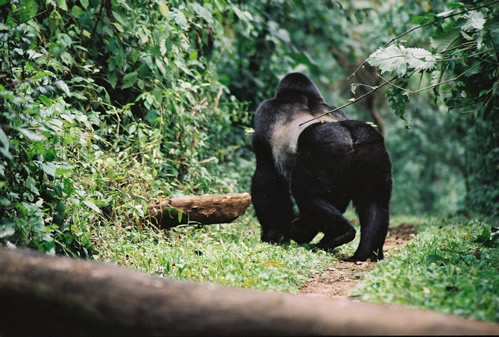 In order to see silverback gorillas in the wild, you have to prepare to visit Africa. Many tour companies offer amazing tours to visit Silverback gorillas. You must be prepared to acquire a gorilla permit and also plan for other costs of gorilla trekking like transport, accommodation and meals. You might want to read about gorilla trekking for the elderly if you are a senior. The best places to see gorillas are in Bwindi National Park, Mgahinga Gorilla National Park, Volcanoes National Park, Virunga National Park and Kahuzi-Biega National Park.
In order to see silverback gorillas in the wild, you have to prepare to visit Africa. Many tour companies offer amazing tours to visit Silverback gorillas. You must be prepared to acquire a gorilla permit and also plan for other costs of gorilla trekking like transport, accommodation and meals. You might want to read about gorilla trekking for the elderly if you are a senior. The best places to see gorillas are in Bwindi National Park, Mgahinga Gorilla National Park, Volcanoes National Park, Virunga National Park and Kahuzi-Biega National Park.


Gorillas are cool! I was reading this for a project about The One and Only Ivan.
Yes Sadie. Gorillas are cool.
It’s good to read and know about how gorillas live in the wild. I wish to visit where they live one day.
ME TOO!!!!!!!!
I am reading this to make a google document about Harambe.
I am reading this for a project I have been doing.
I just trekked to see the Mountain Gorillas up close in Volcano National Park in Rwanda. Worth every penny and every expenditure of energy. I was so glad to take the opportunity and find out the money goes to the local economy. The money collected also helps to protect habitat and fund studies related to their long term survival.
I am doing a school presentation and it’s about Silverback Gorillas. This information helped a lot.
I really enjoyed reading all about the different gorillas in the wild. They are such beautiful and endearing animals. They are so interesting to learn about and I appreciate this opportunity to gain this knowledge.
I am doing a talk for our Vacation Bible school. The children love the animal segment and I love learning about the animals. The Gorilla is one of my favorites.
I think all gorillas are magnificent – especially silverbacks!